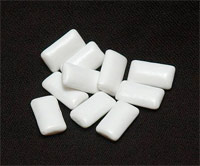 Who would have guessed that an exiled Mexican general boarding with an inventor and photographer on Staten Island, NY, would have led to the invention of modern chewing gum? Strange, but true!
Who would have guessed that an exiled Mexican general boarding with an inventor and photographer on Staten Island, NY, would have led to the invention of modern chewing gum? Strange, but true!
Thomas Adams tried numerous trades before becoming a photographer during the 1860’s. During that time, General Antonio de Santa Anna went into exile from Mexico and boarded with Adams in his Staten Island home. It was Santa Anna who suggested that the unsuccessful but inventive photographer experiment with chicle from Mexican sapodilla trees. Santa Anna felt that chicle could be used to make a synthetic rubber tire; he had friends in Mexico who would be able to supply the product cheaply to Adams.
Thomas Adams first tried to change chicle into synthetic rubber products — toys, masks, rain boots and bicycle tires, but every experiment failed. One day in 1869, he popped a piece of surplus stock into his mouth and liked the taste. Chewing away, he had the idea to add flavoring to the chicle. Shortly after, he opened the world’s first chewing gum factory. In February 1871, Adams New York Gum went on sale in drug stores for a penny a piece.
Thomas Adams sold the gum with the slogan “Adams’ New York Gum No. 1 — Snapping and Stretching.” In 1888, a Thomas Adams’ chewing gum called Tutti-Frutti became the first gum to be sold in a vending machine. The machines were located in a New York City subway station. The firm was the nation’s most prosperous chewing gum company by the end of the century.
For a historical timeline of chewing gum, read on:
Timeline:
- The ancient Greeks chewed mastiche – a chewing gum made from the resin of the mastic tree.
- The ancient Mayans chewed chicle which is the sap from the sapodilla tree.
- North American Indians chewed the sap from spruce trees and passed the habit along to the settlers.
- Early American settlers made a chewing gum from spruce sap and beeswax.
- In 1848, John B. Curtis made and sold the first commercial chewing gum called the State of Maine Pure Spruce Gum.
- In 1850, Curtis started selling flavored paraffin gums becoming more popular than spruce gums.
- On December 28 1869, William Finley Semple became the first person to patent a chewing gum – U.S patent #98,304.
- In 1869, Antonio Lopez de Santa Anna introduced Thomas Adams to chicle.
- In 1871, Thomas Adams patented a machine for the manufacture of gum.
- In 1880, John Colgan invented a way to make chewing gum taste better for a longer period of time while being chewed.
- By 1888, an Adams’ chewing gum called Tutti-Frutti became the first chew to be sold in a vending machine. The machines were located in a New York City subway station.
- In 1899, Dentyne gum was created by New York druggist Franklin V. Canning.
- In 1906, Frank Fleer invented the first bubble gum called Blibber-Blubber gum. However, the bubble blowing chew was never sold.
- In 1914, Wrigley Doublemint brand was created. William Wrigley, Jr. and Henry Fleer were responsible for adding the popular mint and fruit extracts to a chicle chewing gum.
- In 1928, an employee of the Frank H. Fleer Company, Walter Diemer invented the successful pink colored -Double Bubble, bubble gum. The very first bubble gum was invented by Frank Henry Fleer in 1906. He called it Blibber-Blubber. Fleer’s recipe was later perfected by Walter Diemer, who called his product Double Bubble.
Information taken from About.com